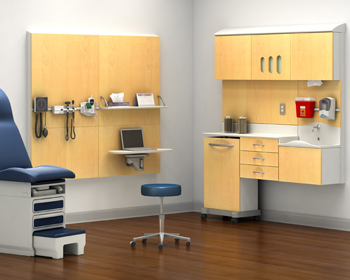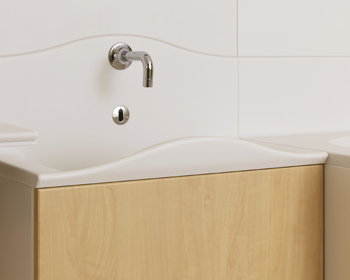Herman Miller Wins Award for Compass System
 The 2012 International Design Excellence Awards (IDEA) recognized Herman Miller’s enhancements its Compass System for health care environments as a finalist in the category of medical and scientific products. The Industrial Designers Society of America has been presenting IDEA awards since 1980. The IDEA recognized Herman Miller for making an “intelligent, adaptable system that creates cost-effective applications for exam rooms and other clinical spaces.”
The 2012 International Design Excellence Awards (IDEA) recognized Herman Miller’s enhancements its Compass System for health care environments as a finalist in the category of medical and scientific products. The Industrial Designers Society of America has been presenting IDEA awards since 1980. The IDEA recognized Herman Miller for making an “intelligent, adaptable system that creates cost-effective applications for exam rooms and other clinical spaces.”
Kurt Kapp, senior product lead for Herman Miller, explained the system was launched in June 2010 after five years of research and conversations with over 600 people who have had direct experience with clinical environments, including patients, doctors, nurses, architects and interior designers.
He added that the company observed shifts at numerous hospitals in various settings to analyze the biggest failings in typical clinical room designs. “We’d watch every step they would make, how many steps they’d make, where they would make them to, how they would use the product, how efficient it was, how inefficient it was, how their reach is — so every aspect of it.”
In terms of patient experience, Kapp said the system strived to break down what can sometimes feel like a stale and detached relationship between patients and medical staff members.
“What we’ve noticed through our research is you have the physician coming in and they are unfortunately positioned with their back to the patient because they are working with a fixed work surface,” He explained. “What we’ve developed is a rotating work surface that rotates out and around 180 degrees, so it allows them to then go ahead and position themselves to keep their eyes on the patient and have that personal one-on-one relationship.”
 The Compass System was also designed to help clinical staff members fight the constant battle against infection and the spread of various ailments. Kapp explained that the first thing most employees consciously do when they enter a patient room is wash their hands. He said nurses and doctors are so focused on this goal they often don’t think about what they actually do before that, which is often to unconsciously put down whatever charts or materials they are carrying on the edge of the sink, possibly contaminating the area most associated with cleanliness. Sinks in the system were specifically designed to combat this, with narrow edges that are rounded to avoid sharp points, but also curved upwards to keep water in and make it difficult to place anything on the edge of the sink, to curb the unconscious instinct to deposit files or charts there.
The Compass System was also designed to help clinical staff members fight the constant battle against infection and the spread of various ailments. Kapp explained that the first thing most employees consciously do when they enter a patient room is wash their hands. He said nurses and doctors are so focused on this goal they often don’t think about what they actually do before that, which is often to unconsciously put down whatever charts or materials they are carrying on the edge of the sink, possibly contaminating the area most associated with cleanliness. Sinks in the system were specifically designed to combat this, with narrow edges that are rounded to avoid sharp points, but also curved upwards to keep water in and make it difficult to place anything on the edge of the sink, to curb the unconscious instinct to deposit files or charts there.
Other adjustments were made to the sink to ensure that potentially dirty water stays inside the sink and doesn’t splash forward onto the clinician. The spout of the sink is slightly bent back on itself, with a slight lip on the front. These effects combine to direct water into the sink, rather than splashing out. The drain was also offset from the spout, so that cascading water won’t aerate the contents of the drain and spread them out into the room. A motion sensor is also recommended to further eliminate contact between employees and the sink.
In terms of looking to the future, Kapp said the system was designed not to anticipate the technology of tomorrow, but to recognize that it’s changing every day at a truly unpredictable pace.
“We heard a couple years ago the technology was changing every six to eight months and, as of late, I’m hearing everything from every one to three months and you see that as well with cell phones and iPads and apps.”
The system was accordingly designed to be highly customizable and versatile to allow it to keep up with changing medical environments.
